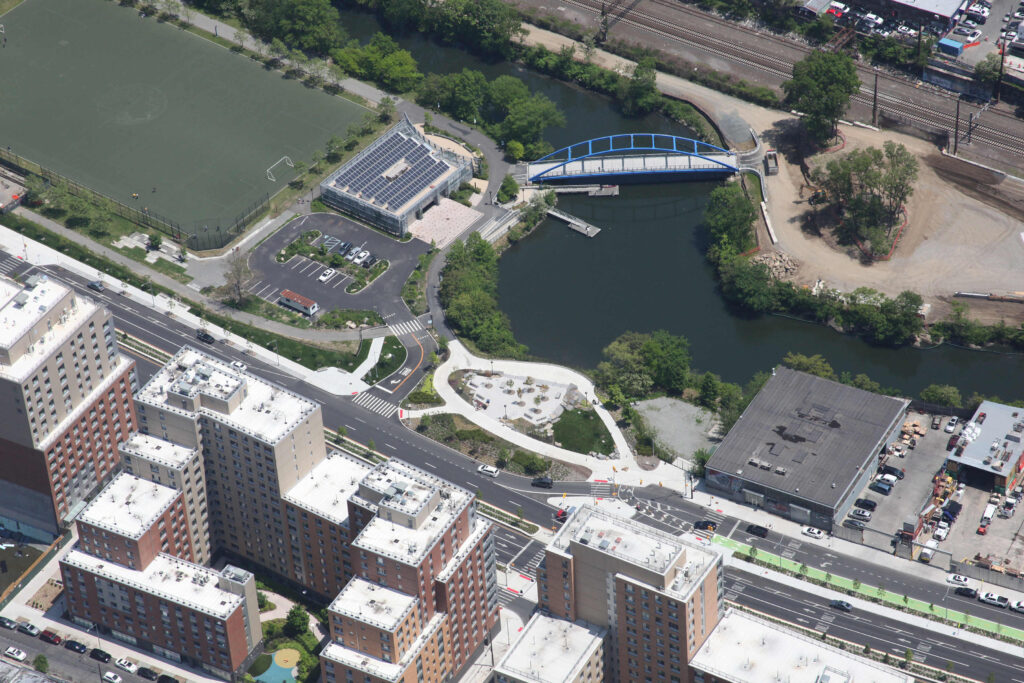Transforming a roadway, reconnecting a Bronx community
Built to speed travelers from one point to the other, highways in the United States historically were planned and constructed with little concern for the communities they displaced or divided. Now — with a renewed focus on equity — cities and states are working to mitigate the resulting impacts.
While removing a roadway from the national highway system might seem cause for concern, for residents of the Crotona neighborhood in Bronx, New York, it was cause for celebration. Converting the 1.3-mile Arthur Sheridan Expressway from an urban principal arterial/interstate to solely serve as an urban principal arterial — making it essentially a boulevard — reconnected the community to the Bronx River waterfront, parklands and greenspaces that had been greatly restricted since the expressway was completed in 1963.
Accomplishing this feat was a complex process and a first for the New York State Department of Transportation (NYSDOT). Our team, as part of a joint venture, helped advance and execute this effort, which improved the community’s quality of life while providing a potential blueprint for other impacted neighborhoods. Here are four essential elements our team embraced that made the project a success.
We listened to the community
Before this project, pedestrian access across the Sheridan Expressway was only available at Westchester Avenue or at East 174th Street. These routes were confusing, congested and circuitous, presenting an additional barrier to the waterfront recreation areas. Residents were outspoken about the need for improved connectivity to the waterfront and parks. The project added three new signalized intersections across the mainline Sheridan Boulevard, vastly improving access and safety.
We prioritized coordination
Projects of this size undertaken in dense urban areas often include work that overlaps into different agencies’ oversight, with work that must be coordinated with and often approved by all these entities. To better facilitate communication and achieve consensus, we partnered with various city, state and federal agencies, from the NYC Department of Parks & Recreation, NYC Department of Transportation and NYC Department of Environmental Protection to the Federal Highway Administration and the US Fish and Wildlife Service. We also helped coordinate public information sessions and meetings with Bronx Community Boards 2 and 6.
We worked as a team
Extensive traffic analysis, engineering and landscape design innovation were required to develop this unique project. Collaboration with multiple agencies and consultants required dedication from each team member to contribute to the project’s success. Whether they were part of the AECOM joint venture, a subconsultant or public agency, each entity played a significant role in advancing this effort. NYSDOT, for example, designed the tied arch pedestrian bridge over the Bronx River. Working as a team, we removed the historic barriers to the parklands and waterfront enabling residents to finally take advantage of the recreational space the neighborhood offers. This included adding transportation and recreation options by building in a two-lane bike path in the median of one of the local avenues.
We designed for safety
To help safeguard pedestrians, we installed high visibility pavement markings and 16-foot-wide refuge islands with bollards. We added three signalized crosswalks and shortened crossing distances by using a protected signal phase. As a result, pedestrians — including students from neighboring schools — can cross Sheridan Boulevard to visit the park without concern about conflicting traffic. We also added buffers and plantings in the median, providing street trees and a vertical-faced decorative barrier on each side of the boulevard.
A blueprint for the future
Taken together, these four factors allowed us to reimagine how the Sheridan Expressway could better function and improve the quality of life for residents in this Bronx neighborhood. In de-designating the Sheridan, our team established a safe, more pleasurable driving and walking experience along the boulevard. Our work also provides a blueprint for other communities across New York State and the country to make similar transformations.







